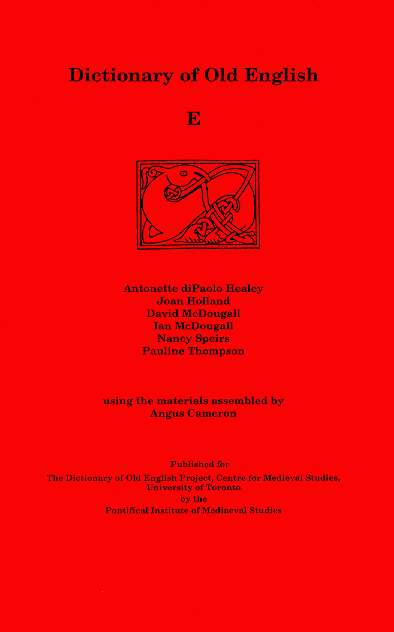1996 – 8 fiche. ISBN 0-88844-927-5 $8.95
Order from the Pontifical Institute of Mediaeval Studies (PIMS)
This sixth fascicle of the Dictionary of Old English, the letter E, consists of 1,450 headwords in 1,643 pages, on microfiche. The material on which E is based represents a fresh look at all surviving Old English (except multiple copies of texts), an estimated three million running words.
In this letter the editors have devised a system of sub-entries for treating verbs whose component elements are calqued on Latin. There are 8 sub-entries under efen~ and 48 sub-entries under efne~, both of which gloss Latin con~ ‘together’; there are 115 sub-entries under eft~, which glosses Latin re~‘back again’. The forms, occurring mainly in Northumbrian glosses, can be identified in the dictionary by a swung dash (~).
The Dictionary of Old English provides an inventory and description of the English language from its earliest appearance in written records, ca. 600. It is intended to complement the Oxford English Dictionary for the earliest period of the language; indeed, the Dictionary of Old English will catalogue the Old English vocabulary deliberately excluded from the OED because it failed to survive past 1150.
The Dictionary draws on as wide a range of texts — in date, dialect and genre — as possible. It differs from previous dictionaries in several important features: a listing in a simplified paradigmatic order of every spelling which is attested for a word in the Electronic Corpus; frequency counts for each word in the Corpus so that readers can know what proportion of the evidence has been cited; usage labels where they are statistically significant, noting restrictions to a class of texts, to an author, or to a particular period or dialect; exhaustive citation for all words of twelve or fewer occurrences.
Fascicle E was prepared by Antonette diPaolo Healey, Joan Holland, David McDougall, Ian McDougall, Nancy Speirs, Pauline Thompson, using materials assembled by the late Angus Cameron.
